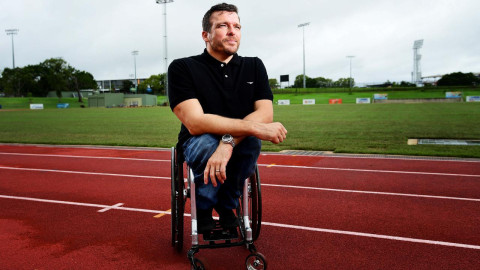
Stephen Lunn, SOCIAL AFFAIRS EDITOR, MELBOURNE
The need for a diagnosis of autism early in a child’s life to secure NDIS support may have “unforeseen consequences” as they face the long-term stigma of being labelled disabled, National Disability Insurance Agency chair Kurt Fearnley says.
As the Albanese government agreed with the states last week to rein in the trajectory of spending in the NDIS already running at $35bn for this year and projected to run to almost $100bn a year in a decade, the three time Paralympian gold-medallist warned growing numbers of children on the NDIS with an autism diagnosis are creating “financial challenges.”
But with anxious parents understandably pursuing what they believe is the best for their child, the NDIS can feel like the only pathway open for them, Mr Fearnley said.
“There are a lot of kids coming onto the scheme. Relatively their packages are pretty small, but when they come together … and where the participant is engaging with the scheme longer than predicted, it does throw a few financial challenges at the scheme,” Mr Fearnley told The Australian.
He said parents worried about their young child having a developmental delay enter a “complicated world of disability … where there is a belief that (the NDIS) is the only lifeboat in the sea.”
“(But) when it comes to the child‘s experience, there are also some unforeseen consequences about having a diagnosis of disability early in a child’s life. There is definitely a stigma. I wish I could say the community doesn’t stigmatise people with disabilities. But we all know that they do.”
“It’s a pretty complicated part of a kid’s life (when) long term issues … of a diagnosis of disability is brought into it,” Mr Fearnley said.
Children being diagnosed with autism is driving up participant numbers in the NDIS, which now sits at about 590,000. Autism is the fastest growing category in the scheme, with services for those with a primary diagnosis of autism accounting for about $8.25bn of the $35bn scheme costs.
The Australian revealed in March that autism experts were concerned young children were being diagnosed with more severe autism than their characteristics warranted to give them a greater chance of securing a place on the NDIS, putting further pressure on the scheme’s finances.
More than 50 per cent of the 288,000 NDIS participants aged under 18 have a primary diagnosis of autism. About 10 per cent of boys and 4 per cent of girls aged five to seven are now on the scheme.
Mr Albanese last week said the current trajectory of costs for the NDIS was “simply not sustainable”, and National Cabinet agreed to target an annual growth rate of 8 per cent by 2026, with further growth moderation beyond that. The October budget had costs rising over the forward estimates by around 14 per cent.
Disability advocates warned a “cap” was being introduced on a supposedly uncapped scheme, and that eligibility of participants into the scheme would inevitably be tightened.
“I know there’s been a lot of fear about the conversation around the 8 per cent,” Mr Fearnley said. “I do not see and will not see this as a cap. But I think the board and the agency are up for an aspirational target of 8 per cent by 2026.”
Despite having an independent review of the scheme underway, and due to report in October, NDIS minister Bill Shorten has flagged its immediate “reboot”, accepting it had “lost its way” and wasn’t delivering the outcomes people with disability deserved.
Mr Shorten said this year’s federal budget will include $720m over four years to build capacity to ensure all spending in the scheme is helping participants meet their goals.
Mr Fearnley said it was appropriate for the review to be examining “who the scheme is for” as well as what is considered “reasonable and necessary” in terms of the supports funded by the NDIS. He said there had been increasing costs in the scheme without a concurrent uplift in outcomes for participants, such as improved employment prospects.
“We do have some wins, we do see the younger participants engaging in employment more often (though) I would like better data about what sort of employment that is.
“(But) in parts of the scheme like Supported Independently Living where you would hope to see more inclusion … and less segregation, unfortunately I don‘t think we are.”
A4 wrote to Mr Fearnley, the NDIA Board Chair, about the article; see https://www.ndisreview.gov.au/submissions/sub-q8v7-001326
A4 has not received a response.